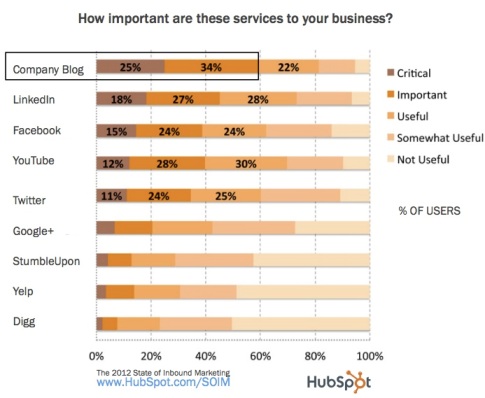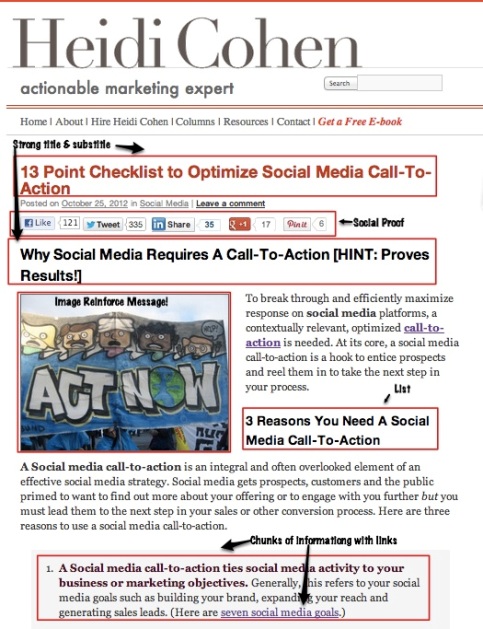Are you happy with the marketing role your blog plays?
Many businesses consider blogs “a cost of doing business,” or code for “We're not sure what it does but we're afraid to stop doing it.”
In this article I will explore why and how to make your blog the hub of your content marketing plan?
Why make your blog your content marketing hub?
To put a slightly different spin on what Chris Brogan says, blogs are your home base; they are at the center of your content marketing system.
Whether you're a small business or a Fortune 100 company, blogs should be at the heart of your content marketing because blogs fuel social media, search optimization and the sales process.
The top five reasons to use a blog as your content hub are:
- Blogs are owned media. Your blog content is yours. You're not at the whim of changes in the rules of third-party platforms, such as the recent changes to LinkedIn, Twitter and Instagram. A blog has the added bonus of providing an always-on crisis management channel to get your message out 24/7.
- Blogs are a form of social media. Through social sharing, comments and guest posts, blogs provide the basis for building a targeted community. In fact, HubSpot‘s research showed that blogs top other forms of social media for effectiveness.

This HubSpot report shows how important blogs are for businesses. - Blogs support search optimization. Because of their structure, blogs are search-friendly. You can enhance this by focusing each article on a specific keyword phrase and link to internal and external content.
- Blogs drive sales. To support sales, write blog posts about how to use your products and show them in context to provide prospects and customers with product information they need. Then link to your specific product pages to support the sales process.
- Blogs incorporate a streamlined CMS (content management system). At its core, blogs are an easy-to-use, low-cost content system.
7 Tips to Make Your Blog Your Content Marketing Hub
To make your blog an accountable aspect of your content marketing plan, here are seven steps to get on track.
#1: Build a Strong Blogging Foundation to Support Your Content Marketing
In order for your blog to be the center of a strong content marketing plan, you'll need to make sure you build your blog on a strong foundation.
One of your first decisions is how to set up your blog. Make sure you use your own URL. The best option is to use a self-hosted WordPress blog. Don't use a free hosting option such as Blogger or WordPress.
Even better, incorporate your blog into your overall business website. Use http://example.com, not http://example.wordpress.com.

You'll need to get technology resources to support your blogging efforts. Blogging should be integrated into your website. For most businesses, this translates to ongoing technology support, rather than a few minutes of someone's time when they're available.
These are essential to a strong foundation.
Get World-Class Marketing Training — All Year Long!
Are you facing doubt, uncertainty, or overwhelm? The Social Media Marketing Society can help.
Each month, you’ll receive training from trusted marketing experts, covering everything from AI to organic social marketing. When you join, you’ll also get immediate access to:
- A library of 100+ marketing trainings
- A community of like-minded marketers
- Monthly online community meetups
- Relevant news and trends updates
#2: Know Your Audience
Before you begin blogging, you'll need to know whom you're writing for and what they're interested in reading. One way to find out more about your audience is to use marketing personas.
Create a set of marketing personas to clarify and give a personality to the people you're trying to reach. It's easier to write for someone you know than a faceless mass. Incorporate their content consumption habits and their social media proclivities.

Marketing personas are important for your blog, as well as other forms of content. If you've got distinctly different audiences you're trying to reach, consider creating more than one blog and related content marketing.
#3: Develop Your Content Marketing Plan
Several components come into making a good content marketing plan. Here's what you'll want to include in your content marketing plan.
Map out your promotional calendar
Start by planning your organization's marketing events for the year and use public holidays where appropriate. The objective is to create hooks around which to develop your content.
In addition to seasons and holidays, consider annual events that apply to your product offering. Include relevant tradeshows and conferences, as well as social media participation.

Discover Proven Marketing Strategies and Tips
Want to go even deeper with your marketing? Check out the Social Media Marketing Podcast! Publishing weekly since 2012, the Social Media Marketing Podcast helps you navigate the constantly changing marketing jungle, with expert interviews from marketing pros.
But don’t let the name fool you. This show is about a lot more than just social media marketing. With over 600 episodes and millions of downloads each year, this show has been a trusted source for marketers for well over a decade.

Outline your major content offerings
Based on the events selected in your promotional calendar, decide what major content offerings you'll create such as conference talks, ebooks and webinars.
Plan ongoing columns and related communications
Think like a magazine and brainstorm regular offerings such as news roundups, customer of the week and interviews. Develop a set of columns to offer either weekly or every other week. This provides the basic structure for your blog's editorial calendar. Include themes such as research. Consider how you'll offer this content to other segments of your audience such as in your regular emails.
Create an editorial calendar
Integrate your events, major pieces of content and regular content offerings into one calendar so you can manage the creation process. It helps to make this part of someone's job description.
Plan extended content usage
Once you've integrated your planned content, assess where you can extend, create or reuse content from your major content marketing offerings on your blog and vice versa.
For example, to promote Content Marketing World, Lee Odden put together an ebook, 29 Content Marketing Secrets and the Secret Agents Who Shared Them. He used the information from the ebook to write 11 separate blog posts and an overview post. In addition, he posted the ebook on SlideShare and encouraged participants to share the content.

#4: Optimize Content to Enhance Effectiveness
Your content isn't finished once it's written or created. You still have to enhance its attractiveness to readers.
Here are some key points to make your content work for your business.
Integrate your 360° brand into each blog post and piece of content
Ensure that your audience can associate your content with your organization. Among the elements to consider are colors, voice, text presentation, sounds, language and visual representation.
Optimize content for search
At a minimum, focus each post or piece of content on a keyword phrase, be sure to include both internal and external links, and add appropriate search-friendly text to non-text content.
Format content to facilitate consumption
Entice readers by making it easy to read your content. Break your content into bite-sized information chunks, use bold type to guide readers who are skimming to grasp the sense quickly and use photographs to attract attention.

#5: Plan Your Content Promotion
Just publishing your content isn't sufficient to reach a broad audience. You'll also need to promote your content so that more of the right people see it.
Here's what you'll need to do to promote your content.
Incorporate automatic blog content delivery
Set up your blog to enable readers to receive your posts via email and feeds without having to think about it.
Leverage social media to distribute
Share your content across the social media platforms relevant to your audience. You can automate this, but I prefer tailored sharing to maximize the impact. Add this activity to your content marketing plan.
Also include social sharing buttons with each blog post and other content to enable readers to share your content.

Extend your content reach
Leverage owned media such as your website and email lists to promote your content.
Where appropriate, use third-party media and advertising to support your efforts. For example, you could ask others to promote your efforts for you.
As you learn more about your blog audience, you'll find ways to improve your blog promotion to increase your reach.
#6: Allocate Resources to Your Blog
To make your blog the heart of your content marketing, you need human and financial resources. Quality content that attracts and converts prospects doesn't just happen when employees have time. These resources may be internal or external.
You'll want to consider a variety of resources. You'll want to look at resources for content creation to develop the information; creative, including design, photography and formatting; editorial to ensure that the content conveys the appropriate ideas, as well as editing to ensure the grammar is correct; marketing to get your content distributed; and technology to facilitate uploading and other technical issues.

#7: Track Content Marketing Results
As with any other business initiative, you must measure your results. Plan your metrics and content creation to ensure that you have integrated the ability to capture the data you need.
Used properly, a blog not only supports your social media, search optimization and sales processes, it acts as the hub for the rest of your content marketing.
What do you think? Is there anything else that you'd add to this list? If so, what would you include and why? Please leave your questions and comments in the box below.
Images from iStockPhoto.
Attention Agency Owners, Brand Marketers, and Consultants

Introducing the Marketing Agency Show–our newest podcast designed to explore the struggles of agency marketers.
Join show host and agency owner, Brooke Sellas, as she interviews agency marketers and digs deep into their biggest challenges. Explore topics like navigating rough economic times, leveraging AI, service diversification, client acquisition, and much more.
Just pull up your favorite podcast app, search for Marketing Agency Show and start listening. Or click the button below for more information.


